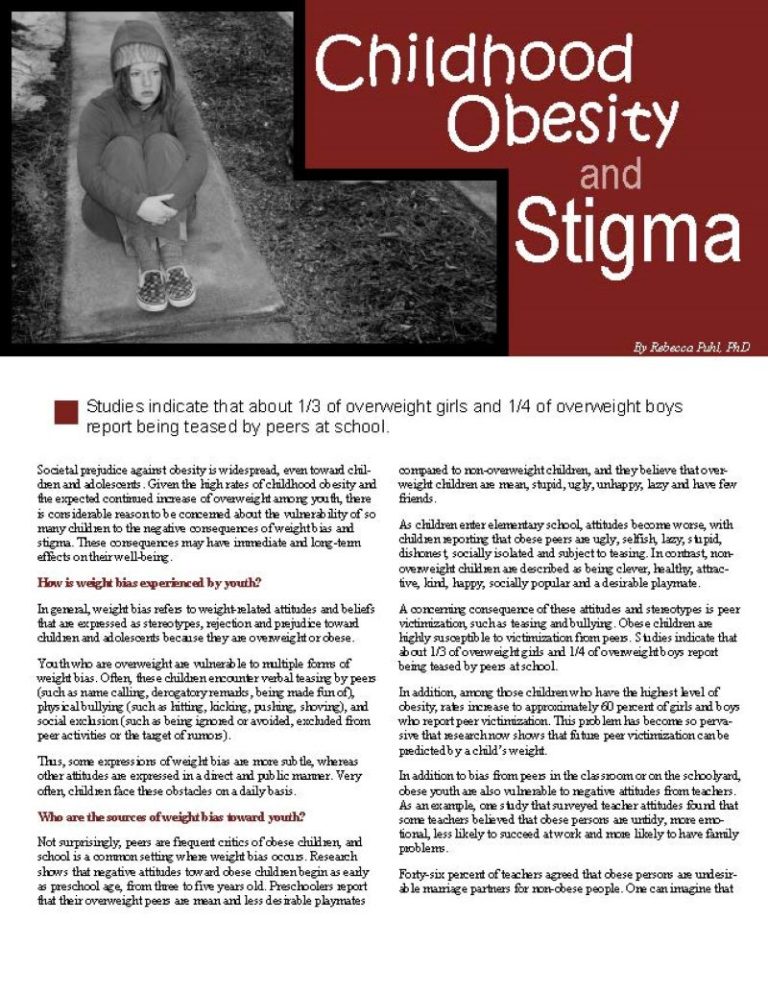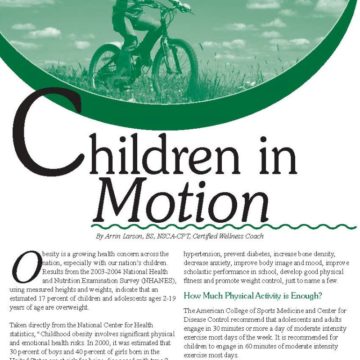Childhood Obesity and Stigma


by Rebecca Puhl, PhD
Spring 2007
Societal prejudice against obesity is widespread, even toward children and adolescents. Given the high rates of childhood obesity and the expected continued increase of overweight among youth, there is considerable reason to be concerned about the vulnerability of so many children to the negative consequences of weight bias and stigma. These consequences may have immediate and long-term effects on their well-being.
How is weight bias experienced by youth?
In general, weight bias refers to weight-related attitudes and beliefs that are expressed as stereotypes, rejection and prejudice toward children and adolescents because they have excess weight or obesity.
Youth who are overweight are vulnerable to multiple forms of weight bias. Often, these children encounter verbal teasing by peers (such as name calling, derogatory remarks, being made fun of), physical bullying (such as hitting, kicking, pushing, shoving), and social exclusion (such as being ignored or avoided, excluded from peer activities or the target of rumors).
Thus, some expressions of weight bias are more subtle, whereas other attitudes are expressed in a direct and public manner. Very often, children face these obstacles on a daily basis.
Who are the sources of weight bias toward youth?
Not surprisingly, peers are frequent critics of children with obesity, and school is a common setting where weight bias occurs. Research shows that negative attitudes toward children with obesity begin as early as preschool age, from three to five years old. Preschoolers report that their overweight peers are mean and less desirable playmates compared to non-overweight children, and they believe that overweight children are mean, stupid, ugly, unhappy, lazy and have few friends.
As children enter elementary school, attitudes become worse, with children reporting that peers with obesity are ugly, selfish, lazy, stupid, dishonest, socially isolated and subject to teasing. In contrast, non-overweight children are described as being clever, healthy, attractive, kind, happy, socially popular and a desirable playmate.
A concerning consequence of these attitudes and stereotypes is peer victimization, such as teasing and bullying. Children with obesity are highly susceptible to victimization from peers. Studies indicate that about 1/3 of overweight girls and 1/4 of overweight boys report being teased by peers at school.
In addition, among those children who have the highest level of obesity, rates increase to approximately 60 percent of girls and boys who report peer victimization. This problem has become so pervasive that research now shows that future peer victimization can be predicted by a child’s weight.
In addition to bias from peers in the classroom or on the schoolyard, youth with obesity are also vulnerable to negative attitudes from teachers. As an example, one study that surveyed teacher attitudes found that some teachers believed that persons with obesity are untidy, more emotional, less likely to succeed at work and more likely to have family problems.
Forty-six percent of teachers agreed that persons with obesity are undesirable marriage partners for non-overweight people. One can imagine that such attitudes could influence teaching practices with students affected by obestiy.
Other research has demonstrated that educators report lower expectations for overweight students than normal weight across a variety of performance areas, and that physical educators perceive overweight students to have worse social, reasoning, physical, and cooperation abilities than non-overweight students. Thus, it is important to recognize that teachers are not immune to societal attitudes and may perpetuate bias unintentionally or through differential treatment of overweight students.
An unexpected source of weight stigma toward youth is parents. Several large studies have examined weight-based teasing and victimization in adolescents, and show that parental bias is common.
For example, in one study, weight-based teasing by family members was reported by as many as 47 percent of overweight girls and 34 percent of overweight boys. Our own research indicates that family members are often reported as the most frequent sources of weight bias.
My colleagues and I studied experiences of weight stigmatization and sources of bias in a sample of over 2,400 adult women with excess weight or obesity. These women reported family members to be the most frequent source of stigma, with 62 percent reporting that family members had stigmatized them on multiple occasions because of their weight. Mothers and fathers were frequently reported in descriptions of their worst stigmatizing experiences.
What are the consequences of weight bias for youth?
Taken together, children face weight bias from multiple sources – from peers, educators and even parents. The impact of weight bias on children is significant, and has negative consequences for their psychological, social and physical health.
Studies show that children with excess weight or obesity who are victimized because of their weight are more vulnerable to depression, anxiety, lower self-esteem and poor body image. In addition, some research has found that youth with obesity who are victimized by their peers are two to three times more likely to engage in suicidal thoughts and behaviors than overweight children who are not victimized.
Weight bias also has consequences for children’s social relationships. Children with obesity are rejected more often by their peers than non overweight students. They are more likely to be socially isolated, and are less likely to be nominated by their peers as friends than non-overweight students.
Finally, weight bias can lead to impairments in children’s physical health. Several studies have demonstrated that weight bias leads to unhealthy eating behaviors. For example, overweight girls and boys who are targets of frequent weight-teasing are more likely to engage in unhealthy weight control and binge eating behaviors than overweight girls and boys who were not teased about their weight.
There is also evidence to suggest that children with obesity are less likely to engage in physical activity because of weight stigma. For example, weight bias expressed by physical education teachers leads overweight students to avoid participating in physical education classes.
Some research has also found that weight bias can negatively impact cardiovascular health outcomes in youth. A recent study found that adolescents who reported unfair treatment because of their physical appearance had higher blood pressure, even after accounting for typical determinants of blood pressure including body weight, gender, race, physical activity, posture, consumption and mood.
These consequences of weight bias can substantially reduce a child’s quality of life. Not surprisingly, research shows that youth with obesity have much lower scores on quality of life compared to non-overweight children, including physical health, psychosocial health, emotional and social well-being and school functioning. This research concluded that children with obesity have a quality of life comparable to children with cancer.
What can parents do to reduce weight bias?
Parents have a critical role to play in reducing bias and improving the lives of overweight children. The following suggestions highlight parental strategies that can be helpful toward these goals.
1. Increase awareness of personal attitudes about weight.
As a parent, it’s important to become aware of your own weight-based assumptions, as these are often communicated to children – even if unintentionally. Here are some questions to consider:
Do I make assumptions based on a person’s weight about their character, intelligence or lifestyle?
What are my views about the causes of obesity?
Does this affect my attitudes toward persons with obesity?
What are common stereotypes about persons with obesity?
Do I believe these to be true or false? Why?
2. Use sensitive and appropriate language about weight.
Children are very perceptive of parental attitudes. Thus, it’s important for parents to avoid making negative comments about their own or other people’s weight in front of their child. Avoid making negative associations with being overweight (e.g., that overweight people are lazy), and be careful not to use pejorative terms to describe body weight. Talk to your child to learn what words they feel comfortable using when talking about weight.
3. Intervene to reduce weight-based teasing.
Parents need to look for signs of peer harassment, teasing, or victimization if their child is overweight. It’s important for parents to talk to children if there is a problem and to find ways to intervene and provide support in dealing with these difficult experiences.
4. Increase awareness of weight bias at school.
Parents can be powerful advocates of change in schools. It can be helpful to talk to teachers or the principal in your child’s school to promote awareness of weight bias. You have the right to express your concerns about this problem and to ask what the school can do to address bias and promote weight tolerance.
5. Find role models to build confidence and self-esteem.
It is important for children to see examples of positive role models who aren’t thin. Teach your child that overweight individuals can be successful and accomplish important goals. Look for examples of individuals who challenge common weight-based stereotypes, and share these with your child.
6. Emphasize health rather than thinness.
Most parents of overweight children want their child to lose weight. But be sure that your focus is on your child’s health – and not just on their appearance or how much they weigh, which can place added pressure on your child and communicate that health is not as important as appearance.
About the Author:
Rebecca Puhl, PhD, is the Coordinator for Community and Weight Stigma Initiatives at the Rudd Center for Food Policy and Obesity at Yale University. Dr. Puhl is responsible for coordinating research and policy efforts aimed at reducing weight bias. Dr. Puhl received her Ph.D. in Clinical Psychology from Yale University. Dr. Puhl is the co-chair of the Weight Bias Task Force of NAASO, and is an editor of the book Weight Bias: Nature, Extent, and Remedies (Guilford Press, 2005).
References:
1. Brownell KD, Puhl RM, Schwartz MB, Rudd L. Weight bias: Nature, extent, and remedies. NY: Guilford Press, 2005.
2. Eisenberg ME, Neumark-Sztainer D, & Story M. Associations of weight-based teasing and emotional well-being among adolescents. Archives of Pediatric & Adolescent Medicine. 2003; 157: 733-738.
3. Puhl R, Latner J. (in press). Obesity, Stigma, and the Health of the Nation’s Children. Psychological Bulletin.
4. Puhl R, Brownell KD. Bias, discrimination, and obesity. Obesity Research. 2001;9:788-805.
5. Puhl R, Brownell KD. Confronting and coping with weight stigma: An investigation of overweight and obesity individuals. Obesity. 2006; 14:1802-1815.
6. Storch EA, Milsom VA, DeBraganza N, Lewin AB, Geffken GR, & Silverstein JH. Peer victimization, psychosocial adjustment, and physical activity in overweight and at-risk-for-overweight youth. Journal of Pediatric Psychology, Advance Access, April 6, 2006; doi: doi:10.1093/jpepsy/jsj113.
by Michelle “Shelly” Vicari Winter 2024 Winter has arrived! Don’t allow the chilly and damp weather to…
Read Articleby Kendall Griffey, OAC Communications Coordinator Winter 2024 The Obesity Action Coalition’s 12th annual Your Weight Matters…
Read Articleby OAC Staff Members Kendall Griffey and Michelle “Shelly” Vicari Winter 2024 In a world that often…
Read Article








